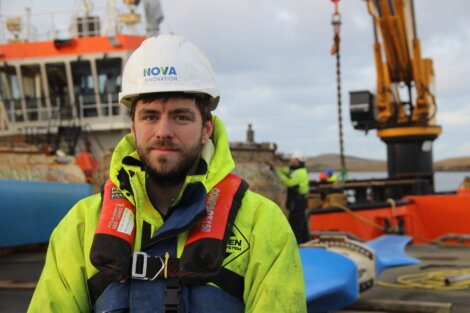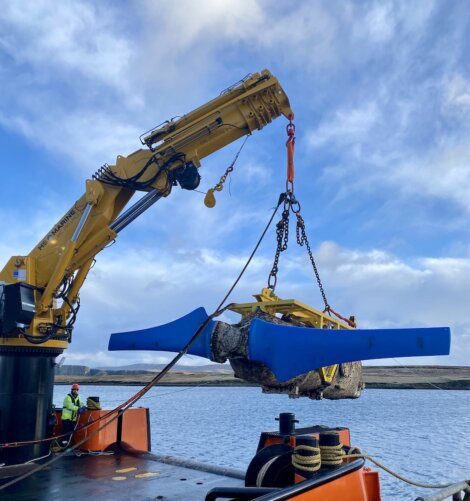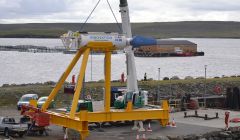Energy / Tidal energy: it’s clean, it’s predictable and it’s invisible
Nova Innovation’s Yell Sound project proves the potential for tidal energy
WITH a large 15MW tidal array now on the horizon for Yell Sound, tidal stream energy appears to be finally on the brink of breaking into the electricity generation mainstream and becoming a serious contributor towards decarbonisation and net zero.
The isles have been playing host to Edinburgh-based Nova Innovation for more than ten years now.
Using Bluemull Sound as its test site, the company has progressed from experimenting with a small 30kw prototype turbine to now operating the world’s first tidal array supplying baseload electricity to the Shetland grid.
Shetland offshore manager Tom Wills says the main thrust of the business during the last few years has been to drive down the cost of tidal energy to make it more competitive on its journey to commercialisation.
With an eye on the current Contracts for Difference (CfD) auction round, which has a £20 million pot of ringfenced money for marine energy projects, Wills is confident that Nova will be “competitive within that bid”.
“Our turbines are getting increasingly reliable, and the whole purpose of this project is to drive down the cost of tidal energy, that’s why we picked Bluemull Sound for the first tidal array,” he explains.
“[At six knots] it’s not the most energetic site in the world but it is a great place for having your first array for generating meaningful amounts of tidal power, proving the technology, and capturing all that learning so that we can move as soon as possible into mass production of these machines.
“No one would be given us any orders for turbines if we didn’t have this Shetland track record.
Become a member of Shetland News
“People are coming into our head office in Edinburgh and can be watching turbines spinning in Bluemull Sound – and we can also show that people on an iPad in Singapore or Halifax.”
Nova currently operates four 100kw turbines in Bluemull Sound with two more waiting to be installed. The machines are mounted on a steel tripod which sits on the seabed held in place by concrete ballast. The tips of the blades are 15 metres below the water surface.
The electricity generated is stored in a 500kw Tesla battery on Cullivoe Pier which feeds base load electricity into the local grid.
One of the big advantages of tidal energy is that the resource is predictable; Wills knows exactly what state the tide will be in ten years’ time on Thursday afternoon. Yet the tides are fluctuating depending on its natural flow and as such 100 per cent generation is not possible.
This is where the battery for energy storage comes in. “The best thing about tidal power is that it is so predictable, and when you combine it with energy storage, as we have done here with a 500kw Tesla battery, it allows us to produce base load electricity into the Shetland grid,” he says.
“So, we can produce a ‘straight line’, and even though the resources are fluctuating, we can produce that straight line.”
Nova’s older machine in Bluemull Sound have a capacity factor in the low to mid 20 per cent – comparable with that of wind turbines spinning in England – and the company’s newer turbine, which does not have a gear box anymore, produces energy at a rate or more than 30 per cent.
Wills says he is confident that once deployed in a stronger tidal flow such as the new development in Nova Scotia the company is involved in, the capacity factor will rise to between 50 and 60 per cent, a rate comparable to the productivity of local wind turbines.
There is no doubt that the potential resource of tidal energy around the UK is vast – after all, the shallow basin of the North Sea is filled twice a day by massive tidal waves racing in from the Atlantic.
According to Wills, the amount of water flowing through Bluemull Sound from the Atlantic into the North Sea and back again, four times a day, is more than in all UK rivers combined.
“We are just scratching the surface,” he says.
Theoretically, Shetland has more than enough natural resource to generate all the electricity that will ever be needed from tidal streams even with increased demand for electricity in transport and heating.
Yell Sound is the obvious next step in the tidal energy journey and securing a seabed lease from the Crown Estate is an essential first step in making the project happen. This now will be followed by consulting the local community and applying for planning and environmental consent, as well securing a grid connection.
“The resource available is certainly larger than Shetland’s electricity demand, and there is some potential to export,” Wills continues.
“We need to make sure that the interconnector benefits a diverse range of energy projects.”
And with an eye on the funds earmarked for net-zero through the much-heralded Islands Deal, Wills pitches the Yell Sound project as “exactly the type of thing that the growth deal could be supporting”.
“There is a great future for tidal energy in Shetland if we get the right support in place at the right time.
“We wouldn’t be able to do this without all the excellent local suppliers we are working with, the blades are manufactured here, and the steel structure is also going to be manufactured in Shetland,” he says.
Become a member of Shetland News
Shetland News is asking its many readers to consider paying for membership to get additional features and services: -
- Remove non-local ads;
- Bookmark posts to read later;
- Exclusive curated weekly newsletter;
- Hide membership messages;
- Comments open for discussion.
If you appreciate what we do and feel strongly about impartial local journalism, then please become a member of Shetland News by either making a single payment, or setting up a monthly, quarterly or yearly subscription.



















































































